Data Centers as Active Multi-Energy Systems for Power Grid Decarbonization: A Technical and Economic Analysis
Abstract
:1. Introduction
2. The Data Center’s Role in the Future Power System
3. Data Centers as Active Multi-Energy Systems: Modeling Aspects and Control Strategies
4. Utilizing Flexibility Options in a Data Center: A Case Study
- full standby mode;
- seasonal mode; and
- multi-discharge mode.
5. Discussion
6. Conclusions
Author Contributions
Funding
Conflicts of Interest
References
- European Commission. Energy Roadmap 2050. 2012. Available online: https://ec.europa.eu/energy/sites/ener/files/documents/2012_energy_roadmap_2050_en_0.pdf (accessed on 10 September 2019).
- Komarnicki, P.; Lombardi, P.; Styczynski, Z. Electric Energy Storage Systems: Flexibility Options for Smart Grid; Springer: Berlin/Heidelberg, Germany, 2017. [Google Scholar]
- Alemany, J.M.; Arendarski, B.; Lombardi, P.; Komarnicki, P. Accentuating the renewable energy exploitation: Evaluation of flexibility options. Int. J. Electr. Power 2018, 102, 131–151. [Google Scholar] [CrossRef]
- Cesena, E.A.M.; Capuder, T.; Mancarella, P. Flexible distributed multienergy generation system expansion planning under uncertainty. IEEE Trans. Smart Grid 2015, 7, 348–357. [Google Scholar] [CrossRef]
- Tran, N.H.; Ren, S.; Han, H.; Jang, S.M.; Moon, S.; Hong, C.S. Demand Response of Data Centers: A Real-time Pricing Game between Utilities in Smart Grid; The Advanced Computing Systems Association: Berkeley, CA, USA, 2014. [Google Scholar]
- Dastbaz, M.; Pattinson, C.; Akhgar, B. Green Information Technology. A Sustainable Approach, 1st ed.; Morgan Kaufmann: Burlington, MA, USA, 2015. [Google Scholar]
- Vasques, T.L.; de Almeida, A.T.; Moura, P.S. Energy Efficiency Insight into Small and Medium Data Centres: A Comparative Analysis Based on a Survey; European Council for Energy Efficiency Economy (ECEEE): Stocholm, Sweden, 2017. [Google Scholar]
- Lombardi, P.; Hänsch, K.; Arendarski, B.; Komarnicki, P. Information and power terminals: A reliable microgrid infrastructure for use in disaster scenarios. Int. J. Crit. Infr. Prot. 2017, 19, 49–58. [Google Scholar] [CrossRef]
- Hauer, I.; Rohrig, C.; Rudion, K.; Styczynski, Z.A.; Naumann, A.; Komarnicki, P. Concept, architecture and components of a smart distribution control center. In Proceedings of the IEEE Grenoble Conference PowerTech, POWERTECH, Grenoble, France, 16–20 June 2013. [Google Scholar]
- Arlitt, M.; Bash, C.; Blagodurov, S.; Chen, Y.; Christian, T.; Gmach, D.; Hyser, C.; Kumari, N.; Liu, Z.; Marwah, M.; et al. Towards the design and operation of net-zero-energy data center. In Proceedings of the 13th Intersociety Conference on Thermal and Thermomechanical Phenomena in Electronic Systems, San Diego, CA, USA, 30 May–1 June 2012; pp. 552–561. [Google Scholar]
- Liu, Z.; Chen, Y.; Bash, C.; Wierman, A.; Gmach, D.; Wang, Z.; Marwah, M.; Hyser, C. Renewable and cooling aware workload management for sustainable data centers. ACM SIGMETRICS/Performance. In Proceedings of the 12th Joint ACM SIGMETRICS//Performance Conference, London, UK, 11–15 June 2012; pp. 175–186. [Google Scholar]
- Zhou, R.; Wang, Z.; McReynolds, A.; Bash, C.E.; Christian, T.W.; Shih, R. Optimization and control of cooling microgrids for data centers. In Proceedings of the 13th Intersociety Conference on Thermal and Thermomechanical Phenomena in Electronic Systems, San Diego, CA, USA, 30 May–1 June 2012; pp. 338–343. [Google Scholar]
- Cao, X.; Zhang, J.; Poor, H.V. Data center demand response with on-site renewable generation: A bargaining approach. IEEE/ACM Trans. Netw. 2018, 26, 2707–2720. [Google Scholar] [CrossRef]
- Chalise, S.; Golshani, A.; Awasthi, S.R.; Ma, S.; Shrestha, B.R.; Bajracharya, L.; Sun, W.; Tonkoski, R. Data center energy systems: Current technology and future direction. In Proceedings of the IEEE Power Society, General Meeting, Denver, CO, USA, 26–30 July 2015. [Google Scholar]
- AlLee, G.; Tschudi, W. Edison’s data center: 380 Vdc brings reliability and efficiency to sustainable data centers. IEEE Power Energy Mag. 2012, 10, 50–59. [Google Scholar] [CrossRef]
- Guo, Y.; Gong, Y.; Gang, Y.; Khargonekar, P.P.; Geng, Y. Energy and network aware workload management for sustainable data centers with thermal storage. IEEE Trans. Parallel Distrib. Syst. 2014, 25, 2030–2042. [Google Scholar] [CrossRef]
- Rose, I.; Fleischer, A.S. Analysis of a water tank energy storage system for use in a warm water cooled data center. In Proceedings of the IEEE Intersociety Conference on Thermal and Thermomechanical Phenomena in Electronic Systems (ITherm), Las Vegas, NV, USA, 31 May–3 June 2016. [Google Scholar]
- Chiaraviglio, L.; Cianfrani, A.; Listani, M.; Liu, W.; Polverini, M. Lifetime-aware could data centers: Models and performance evaluation. Energies 2016, 9, 470. [Google Scholar] [CrossRef]
- Zhang, X.; Lindberg, T.; Xiong, N.; Vyatkin, V.; Mousavi, A. Cooling energy consumption investigation of data center IT room with vertical placed server. Energy Procedia 2017, 105, 2047–2052. [Google Scholar] [CrossRef]
- Bertoldi, P.; Avgerinoug, M.; Castellazzi, L. Trends in Data Center Energy Consumption Under the European Code of Conduct for Data Centre Energy Efficiency; European Commission: Ispra (VA), Italy, 2017; Available online: https://www.researchgate.net/publication/322223249_Trends_in_data_centre_energy_consumption_under_the_European_Code_of_Conduct_for_data_centre_energy_efficiency (accessed on 10 September 2019). [CrossRef]
- International Organization for Standardization. Information Technology—Data Centres—Key Performance Indicators—Part 2: Power Usage Effectiveness (PUE); ISO/IEC 31134-2: 2016; International Organization for Standardization: Geneva, Switzerland, 2016. [Google Scholar]
- International Energy Agency (IEA). Global EV Outlook 2019; IEA: Paris, France, 2019; Available online: https://www.iea.org/publications/reports/globalevoutlook2019/ (accessed on 10 September 2019).
- Klabunde, C.; Moskalenko, N.; Styczynski, Z.; Lombardi, P.; Komarnicki, P. Use of energy storage systems in low voltage networks with high photovoltaic system penetration. In Proceedings of the IEEE PowerTech Conference, Eindhoven, The Netherlands, 29 June–2 July 2015. [Google Scholar]
- Song, Z.; Zhang, X.; Eriksson, C. Data center energy and cost saving evaluation. Energy Procedia 2015, 75, 1255–1260. [Google Scholar] [CrossRef]
- Xu, J.; Wang, R.Z.; Li, Y. A review of available technologies for seasonal thermal energy storage. Sol. Energy 2014, 103, 610–638. [Google Scholar] [CrossRef]
- Yan, C.; Shi, W.; Li, X.; Zhao, Y. Optimal design and application of a compound cold storage system combining seasonal ice storage and chilled water storage. Appl. Energy 2016, 171, 1–11. [Google Scholar] [CrossRef]
- Carbonell, D.; Philippen, D.; Haller, M.Y.; Brunold, S. Modeling of an ice storage buried in the ground for solar heating applications. Validations with one year of monitored data from a pilot plant. Sol. Energy 2016, 125, 398–414. [Google Scholar] [CrossRef]
- Yan, C.; Shi, W.; Li, X.; Wang, S. A seasonal cold storage system based on separate type heat pipe for sustainable building cooling. Renew. Energ 2016, 85, 880–889. [Google Scholar] [CrossRef]
- Liu, Z.; Wierman, A.; Chen, Y.; Razon, B.; Chen, N. Data center demand response: Avoiding the coincident peak via workload shifting and local generation. Perform. Eval. 2013, 70, 770–791. [Google Scholar] [CrossRef] [Green Version]
- Wang, H.; Huang, J.; Lin, X.; Mohsenian-Rad, H. Proactive demand response for data centers: A win-win solution. IEEE Trans. Smart Grid 2015, 3, 1584–1596. [Google Scholar] [CrossRef]
- WINDNODE Project. Utilisation before Limitation. Available online: https://www.windnode.de/en/newsdetail/news/nutzen-statt-abregeln (accessed on 11 October 2018).
- SimulationX by ESI. Available online: https://www.simulationx.com/ (accessed on 10 September 2019).
- Thomas, J.; Bruschi, J.; Anliker, R.; Bulger, N.; Sau, A.; McDonald, J.; Weale, J.; Rumsey, P.; Mahdavi, R.; Mathew, P.; et al. Data Center Best Practices Guide Energy Efficiency Solutions for High-Performance Data Centers; Pacific Gas and Electric Company: Sacramento, CA, USA, 2012. [Google Scholar]
- Salom, J.; Urbaneck, T.; Oró, E. Advanced Concepts for Renewable Energy Supply of Data Centers; River Publisher: Gistrup, Denmark, 2017. [Google Scholar]
- ASHRAE. Data Center Power Equipment Thermal Guidelines and Best Practices. Whitepaper created by ASFRAE Technical Committee (TC) 9,9 Mission Critical Facilities, Data Centers, Technology Spaces, and Electronic Equipment. 2016. Available online: https://tc0909.ashraetcs.org/documents/ASHRAE_TC0909_Power_White_Paper_22_June_2016_REVISED.pdf (accessed on 10 September 2019).
- Durand-Estebe, B.; Le Bot, C.; Mancos, J.N.; Arquis, E. Simulation of a temperature adaptive control strategy for an IWSE economizer in a data center. Appl. Energy 2014, 134, 45–56. [Google Scholar] [CrossRef]
- Oró, E.; Salom, J. Energy model for thermal energy storage system management integration in data centres. Energy Procedia 2015, 73, 254–262. [Google Scholar] [CrossRef]

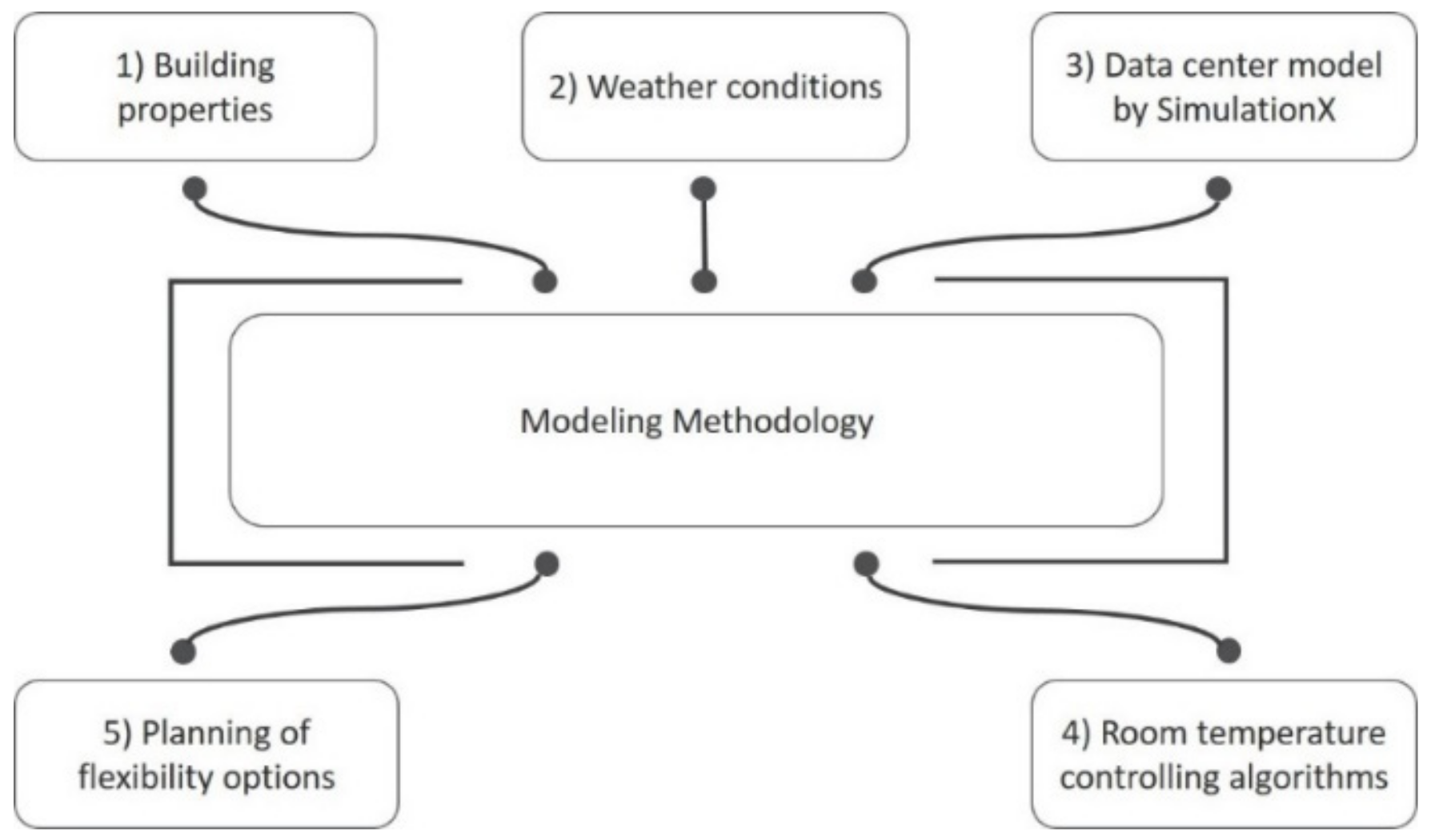
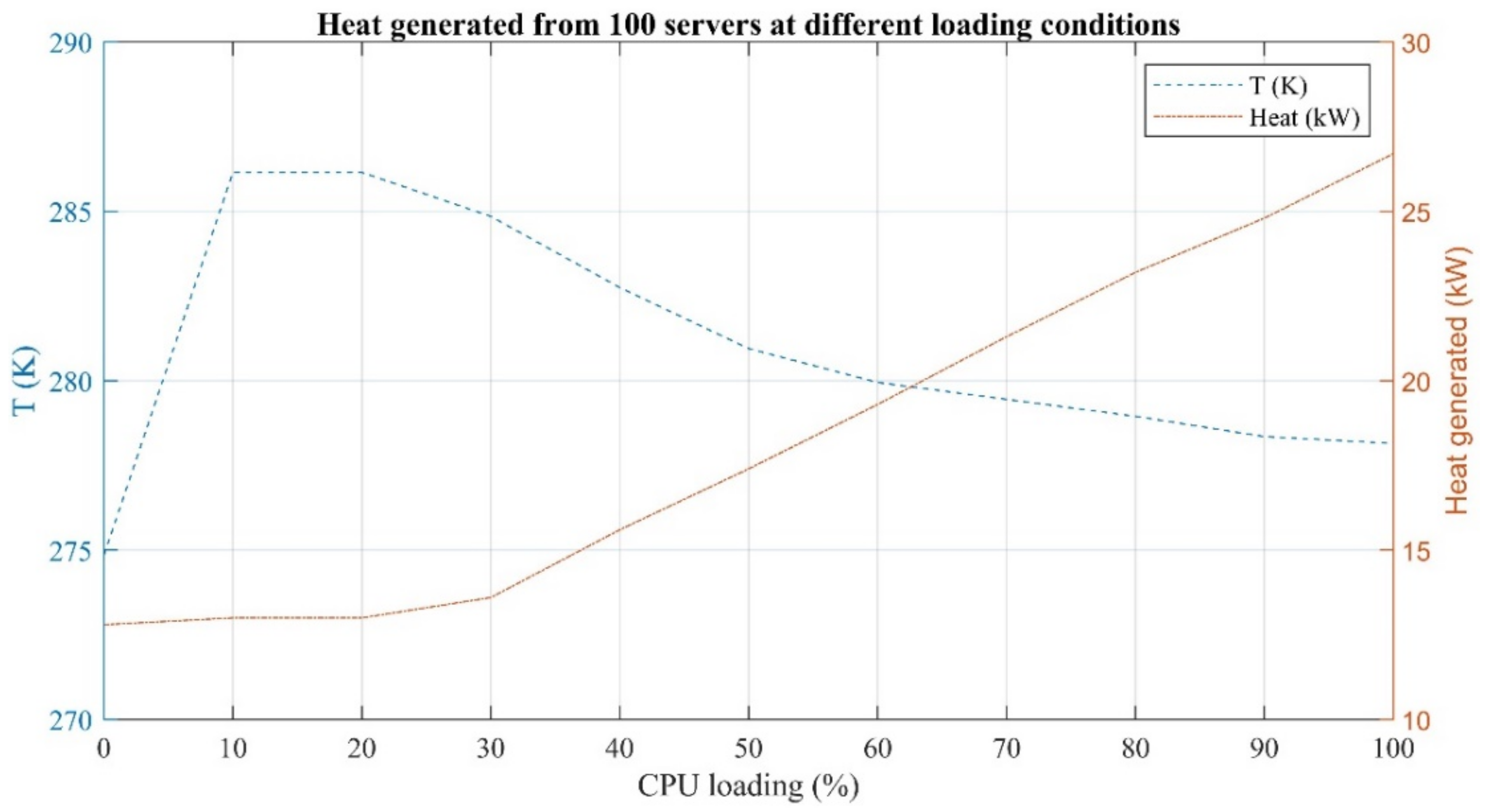
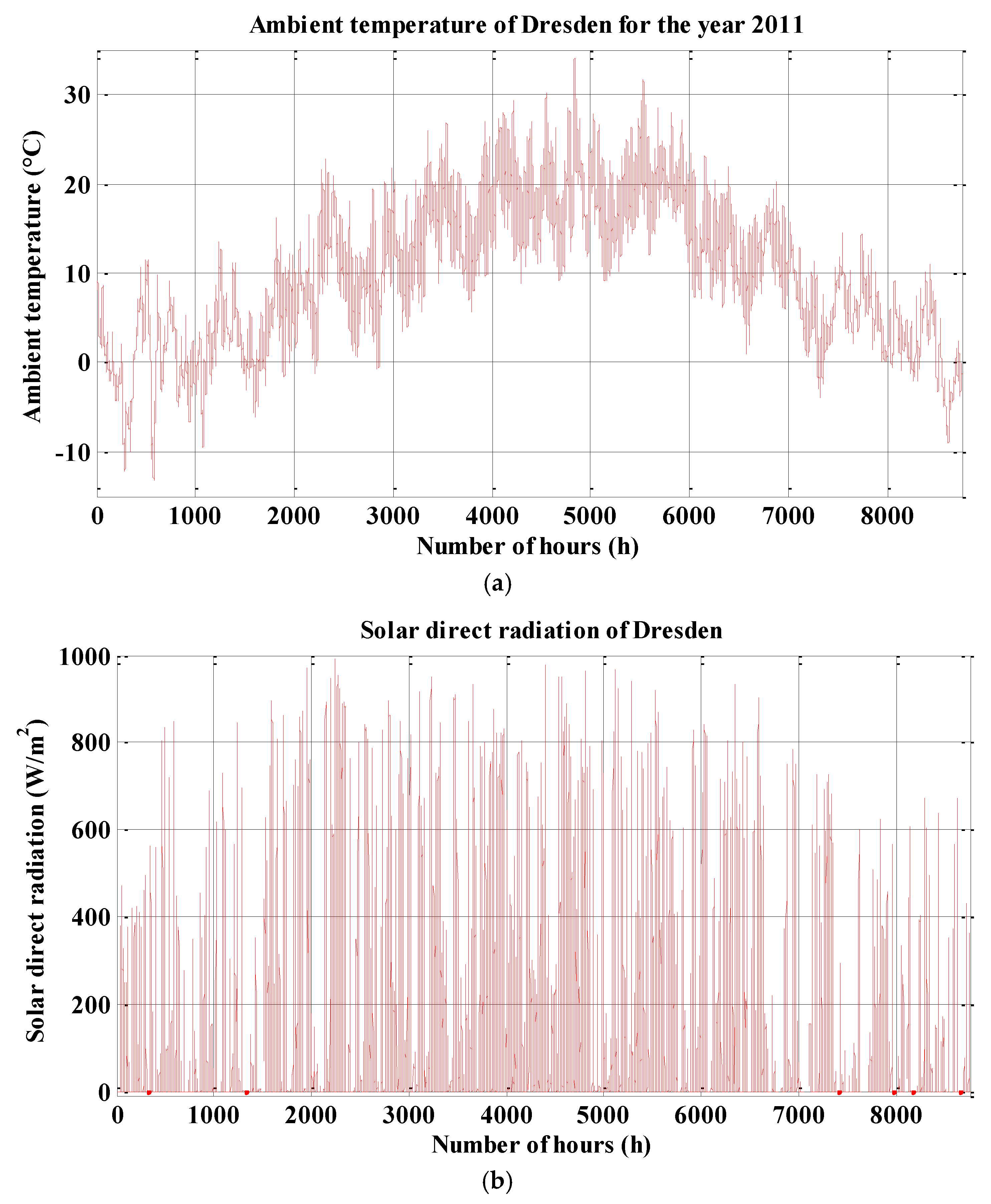
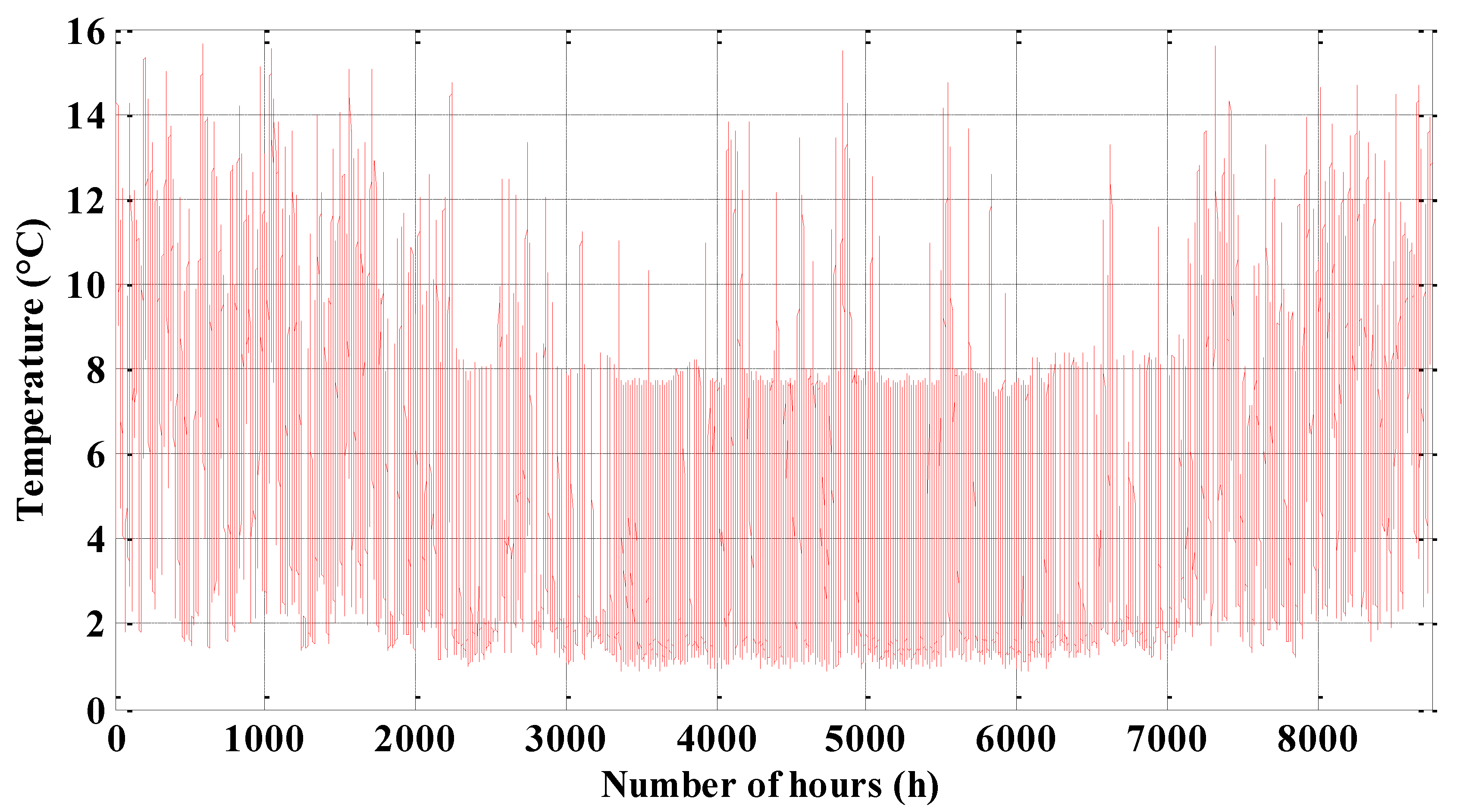

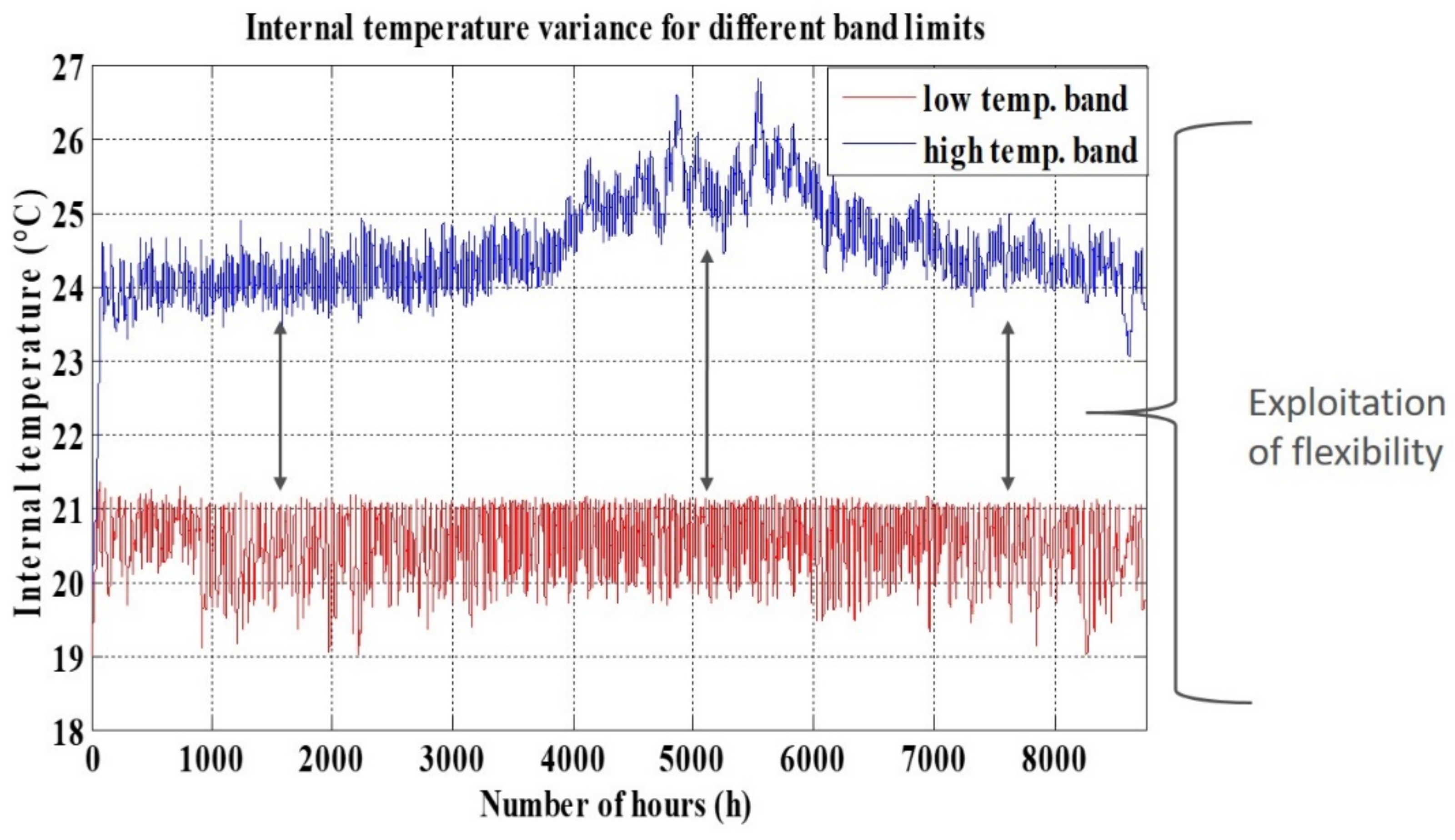
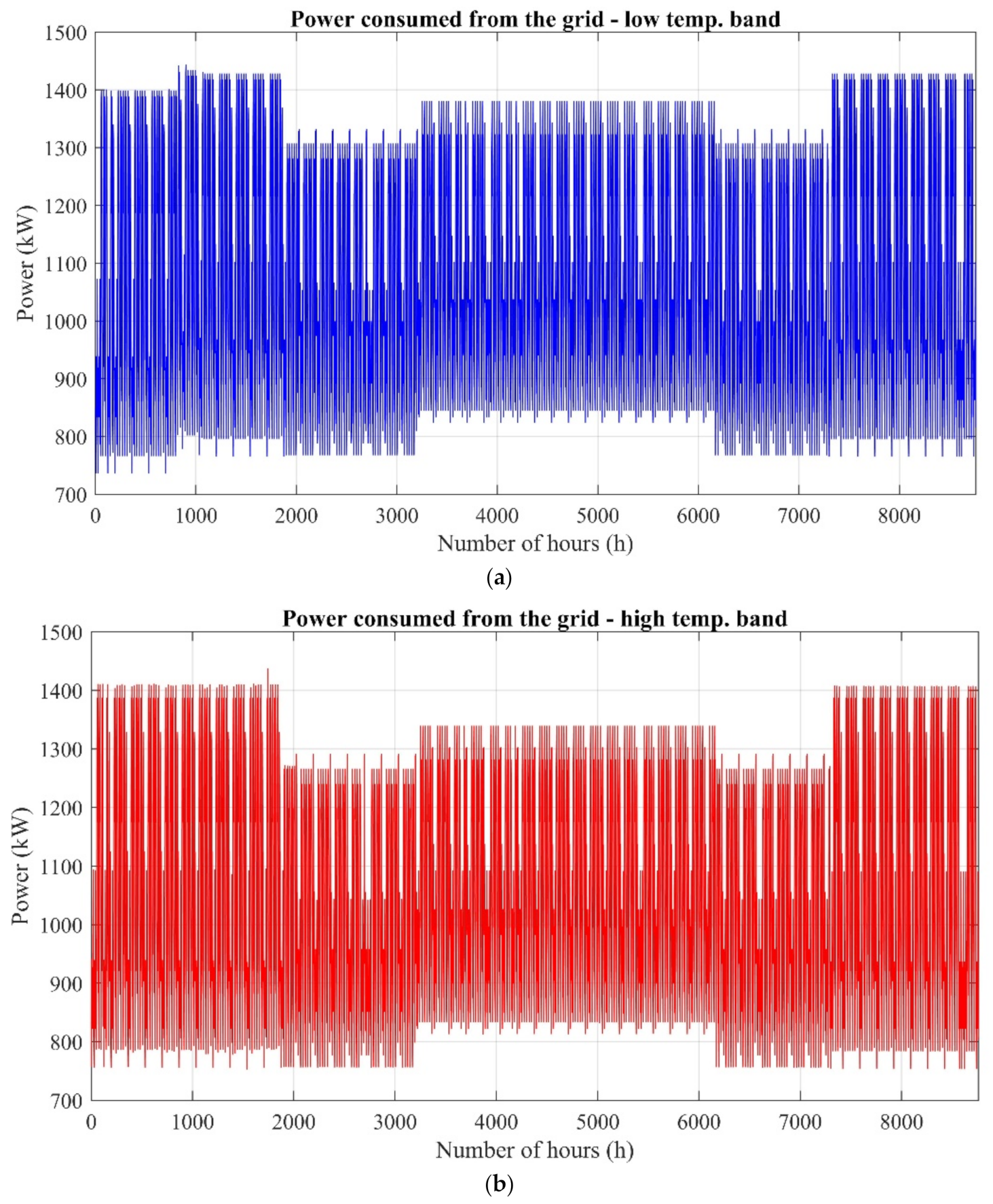
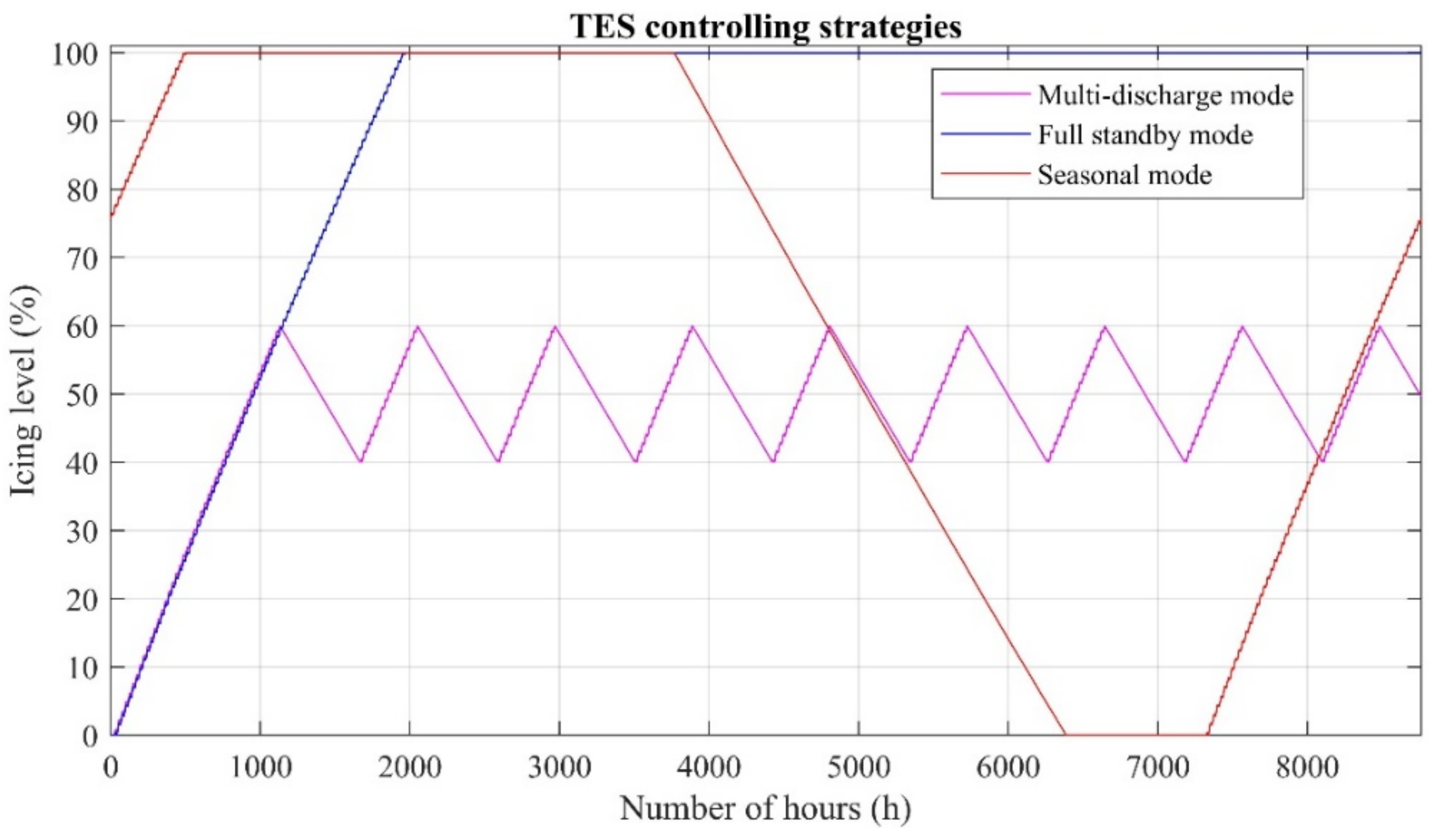
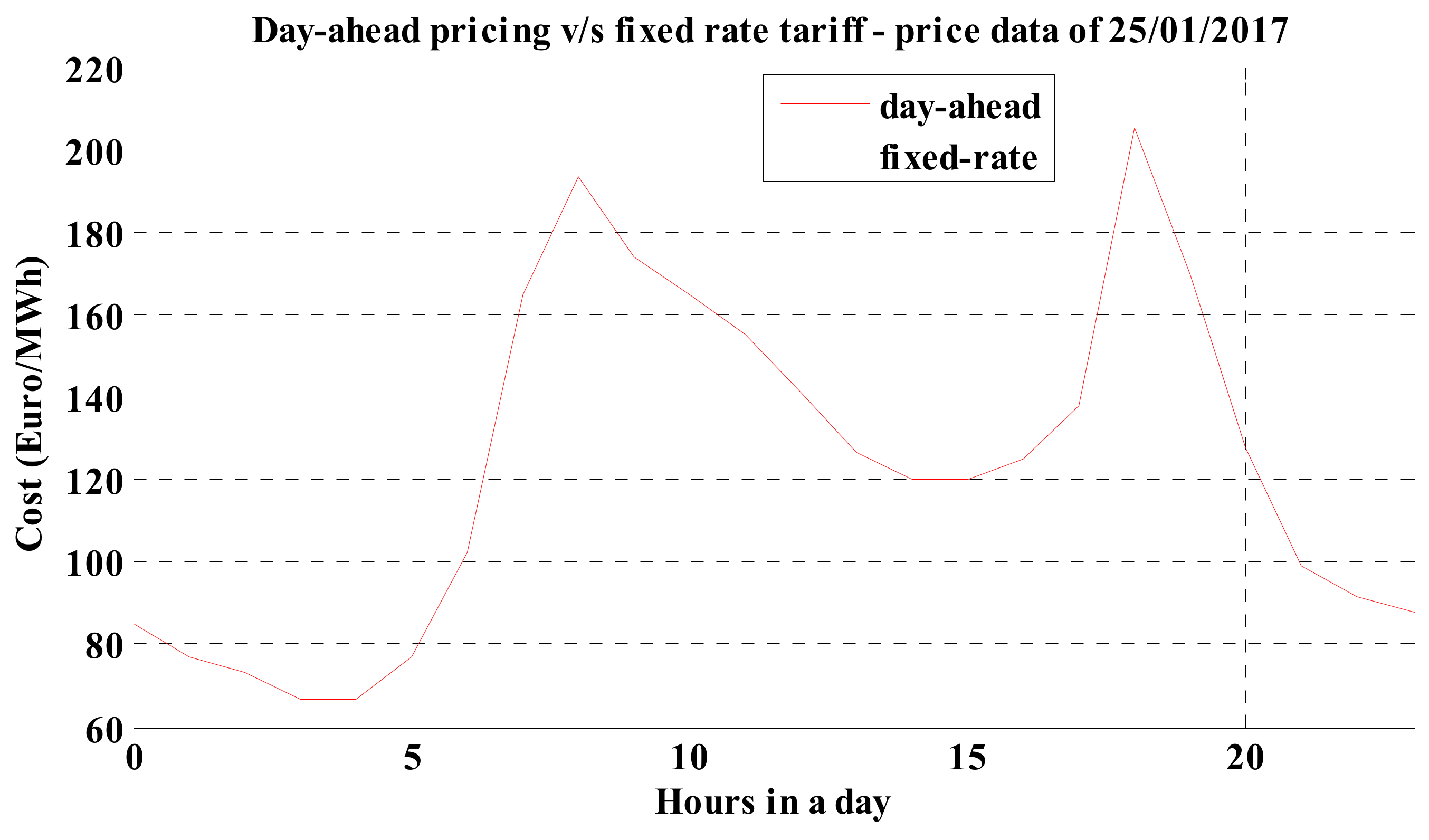
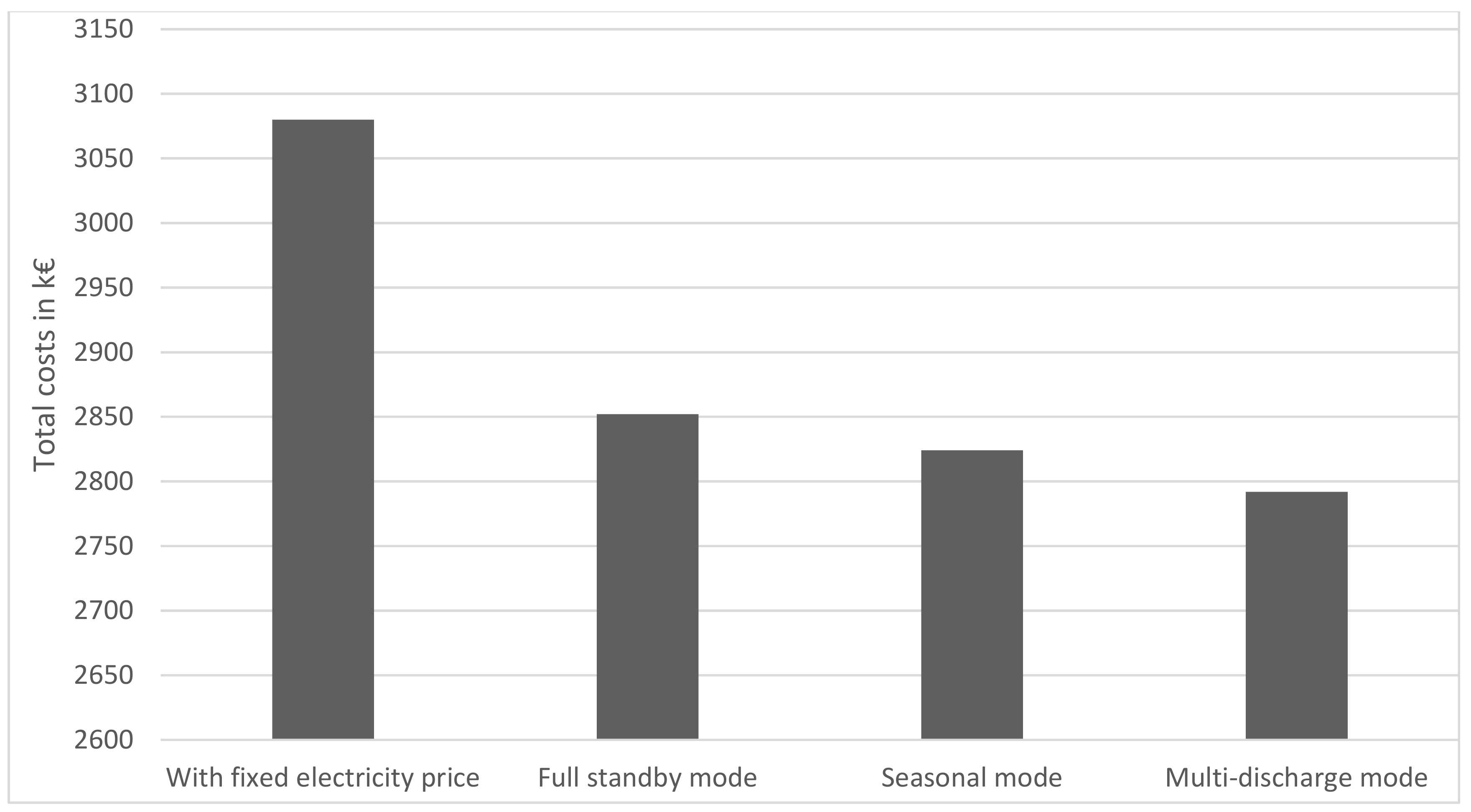
| Symbol | Parameter | Unit |
|---|---|---|
| Qremove | Heat to be removed from a DC | kW |
| Qserver | Heat generated by servers | kW |
| Qsol | Heat caused by solar gain | kW |
| Qtrans | Heat transmitted by walls | kW |
| g | Heat transmission coefficient of windows | W/m2 |
| Ai | Boundary surface | m2 |
| Ii | Solar incidence angle | ° |
| Ui | Boundary’s thermal transmittance | W/m2 |
| Troom | Server room temperature | °C |
| Tambient | Ambient temperature | °C |
| Parameters | Value |
|---|---|
| Building type | Nonresidential building |
| Cooling area | 20,363 (m2) |
| Clear room height | 3.4 (m) |
| Number of floors | 4 (-) |
| Annual specific electric energy consumption | 438 (kWh/m2) |
| Symbol | Parameter | Value |
|---|---|---|
| Total capital expenditures | To be evaluated | |
| Capital expenditures for the heat pump with controller, refrigerant and water supply | ||
| Capital expenditures for the ice storage unit with heat exchangers | ||
| Capital expenditures for the circulation pumps | ||
| Capital expenditures for backup storage units | ||
| Capital expenditures for the piping, temperature and flow sensors, volumetric flow controller, installation and maintenance | ||
| Electricity price | in the case of fixed electricity price or evaluated according to Figure 10 when the price is variable | |
| Power price | ||
| Number of hours (h) | Evaluated using the simulations | |
| Electricity consumed at h-th hour (MWh) | Dependent on the control strategy analyzed | |
| Maximum electric energy consumed (kW) | Dependent on the control strategy analyzed |
| TESS Controlling Strategy | PUE |
|---|---|
| Full standby mode | 1.44 |
| Seasonal mode | 1.42 |
| Multi-discharge mode | 1.38 |
© 2019 by the authors. Licensee MDPI, Basel, Switzerland. This article is an open access article distributed under the terms and conditions of the Creative Commons Attribution (CC BY) license (http://creativecommons.org/licenses/by/4.0/).
Share and Cite
Lombardi, P.A.; Moreddy, K.R.; Naumann, A.; Komarnicki, P.; Rodio, C.; Bruno, S. Data Centers as Active Multi-Energy Systems for Power Grid Decarbonization: A Technical and Economic Analysis. Energies 2019, 12, 4182. https://doi.org/10.3390/en12214182
Lombardi PA, Moreddy KR, Naumann A, Komarnicki P, Rodio C, Bruno S. Data Centers as Active Multi-Energy Systems for Power Grid Decarbonization: A Technical and Economic Analysis. Energies. 2019; 12(21):4182. https://doi.org/10.3390/en12214182
Chicago/Turabian StyleLombardi, Pio Alessandro, Kranthi Ranadheer Moreddy, André Naumann, Przemyslaw Komarnicki, Carmine Rodio, and Sergio Bruno. 2019. "Data Centers as Active Multi-Energy Systems for Power Grid Decarbonization: A Technical and Economic Analysis" Energies 12, no. 21: 4182. https://doi.org/10.3390/en12214182
APA StyleLombardi, P. A., Moreddy, K. R., Naumann, A., Komarnicki, P., Rodio, C., & Bruno, S. (2019). Data Centers as Active Multi-Energy Systems for Power Grid Decarbonization: A Technical and Economic Analysis. Energies, 12(21), 4182. https://doi.org/10.3390/en12214182







